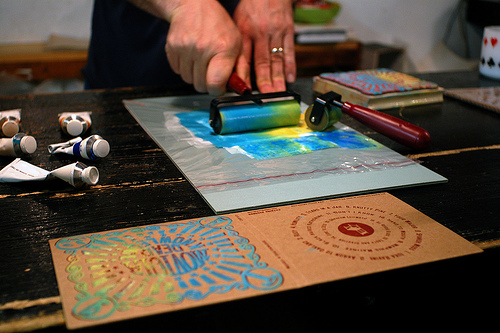
Moviola, “Dead Knowledge”. Catbird Records, CBR010, 2007. Image courtesy of Catbird Records.
Ryan Catbird has commanded a silent influence on the independent music scene since he began his blog, The Catbirdseat, in 2002. Ryan could possibly be credited for bringing bands such as Destroyer, Beirut, Frightened Rabbit, Pete and the Pirates closer to the public spotlight. Anyone who follows his blog would probably agree: Ryan Catbird has an honest, sincere, and genuine passion for music, with no pretense attached whatsoever. Which is why Ryan would probably never credit himself for “breaking” a band…and also why you would expect him to do more than just write about music.
In 2005, Ryan took this passion a step further by launching a boutique record label, Catbird Records. Through over 20 releases, the label has not just built a foundation of releasing reputably great music, but they’ve also managed to add a touch of personality by way of packaging and presentation. Jewel cases be damned—just about every release is a reflection of the care that went into the overall process. Machines didn’t put these packages together; people did.
The label’s most recent release is an LP reissue of the 2002 Unbunny album, Black Strawberries—the album’s first-ever vinyl pressing. This was no ordinary release, however. In one of the more exciting uses of the Kickstarter, Ryan was able to fund the entire process, releasing not just an album, but also an entire experience. I recently spoke to Ryan via email to learn more about this latest release, as well as his process.
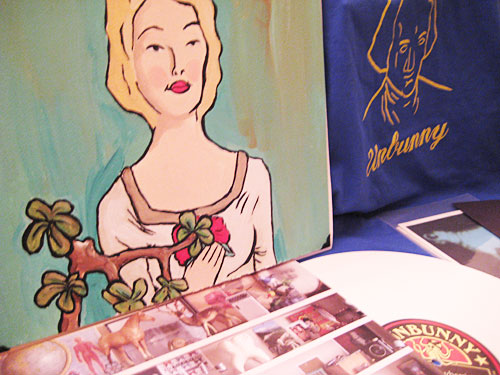
Unbunny, “Black Strawberries” deluxe edition, one of the 75. Catbird Records, CSP008, 2010.
Jonathan Munar: There must be plenty of albums that you think deserve the “deluxe reissue” treatment. How did you arrive at Unbunny’s Black Strawberries for your inaugural Kickstarter project?
Ryan Catbird: It’s true that my head holds a long list of worthy reissues, but I think Black Strawberries was at the fore for this one simply because it’s the one I’ve pined for (vinyl-wise) the most over this last handful of years. And I definitely pined, because when I really love an album (as I do Black Strawberries), I always want it on vinyl. We listen to a lot of records in my house, and certainly not for any sort of “indie hipness” reasons, and not necessarily for nostalgia’s sake, but because I really like to sit down and actively listen to albums—as opposed to them just being background noise while I do something else—and the LP format really lends itself to that.
JM: Let’s talk a bit about the packaging process. It was nice to see a return of the one-of-a-kind, hand-painted packaging, which you used for the outer sleeves of the Black Strawberries deluxe version, and which you introduced with the very first Catbird Records release in 2005 (a split LP with Michael Holt and Someone Still Loves You Boris Yeltsin). What inspired the return to this process?
RC: Ha, I think it was less “inspiration” in this case, and more just a “creative solution” to a situation! The situation being that during the early funding phase, I sold a lot of people on copies of a (nebulous at that time) “Deluxe” edition of the LP. At the time, I had no concrete idea about just what exactly would comprise a “Deluxe” edition, but once I had 75 people committed to paying $40 each for them, I really needed to sit down and figure out a way to give all those people some real bang for those bucks they so generously pledged. The hand-painting came to mind because it adds such a unique value to every copy, and, from a budgetary standpoint, only costs as much as paint and paper stock (assuming my time and labor is equivalent to $0).
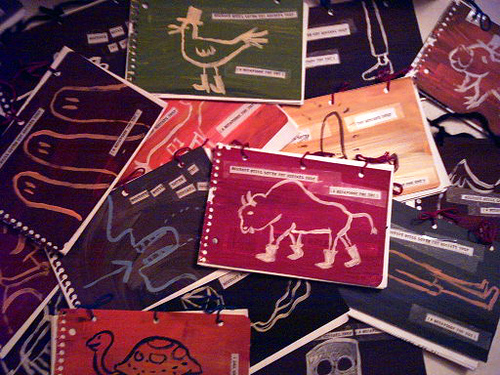
Someone Still Loves You Boris Yeltsin/Michael Holt split, “Someone Still Loves You Michael Holt: A Scrapbook For You”. Catbird Records, CBR001, 2005. Image courtesy of Catbird Records.
JM: The Michael Holt/SSLYBY split was an edition of 250, while the Black Strawberries sleeves were an edition of 75. How do the processes compare between both projects? Do you do all of that painting yourself?
RC: The difference between that first one and this one was that with the split, I had a lot of help in the fabrication. I had a “construction party” one night at my house, and all my friends came over and help piece all the copies together. On top of that, the responsibility for this pressing was split up amongst Holt, Yeltsin, and myself, meaning that I was only responsible for fabricating about 83 copies. But though I did have help on the actual package construction, I did do all of those cover paintings on my lot alone (Holt and Yeltsin both painted their own respective sets). With Unbunny, I handled everything, and again, I did all the paintings myself. And the biggest difference between the Holt/Yelstin split and Black Strawberries is that painting the first one was a much simpler process—those covers were essentially a background color and line art on top. With Black Strawberries, the paintings were all much more elaborate and substantial and required quite a bit more time and effort to complete.
JM: All of the items in the Black Strawberries deluxe version utilize techniques and formats that you used in previous releases—the aforementioned hand-painted component; the Catbird Mini 7″ sleeve; the black paper sleeve—but one format, which you haven’t used in a while, is the hand-screened arigato sleeve. In fact, PWRFL Power used that same type of packaging for the album that followed his own EP on Catbird Records. Have you decided to no longer produce that type of packaging? If so, why?
RC: There are a few reasons why I phased out of the screenprinted sleeves, and both of them are practical. First, the japanese Gocco company, which manufactured my screening setup, went under. The supplies—the inks, the bulbs, the screens—became increasingly hard to procure, and are actually now pretty much nonexistent. On top of that, I decided I needed to switch from a “selling inventory” kind of process to a more “on demand” system. So I invested in a disc replicator and large-format Epson pigment printer, and now, instead of sitting on a large pile of inventory that hangs around waiting to be bought, I’ve got a pretty modular system where I can just fabricate a copy of a release as the orders are placed.
Just to be clear: I love those screenprinted packages, and I really do wish I could continue doing them, but it’s hard to justify the cost and labor involved with those, particularly when it becomes harder and harder with each passing day to sell a CD copy of anything—screenprinted sleeve or otherwise.
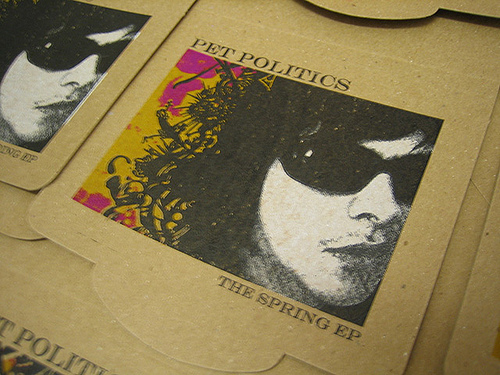
Pet Politics, “The Spring” EP. Catbird Records, CBR007, 2006. Image courtesy of Catbird Records.
JM: It’s really fascinating—and totally logical—how your process has evolved from a “selling inventory” model to a “print on demand” model. In fact, you have quite often advocated for labels/publications/etc. to shift to print-on-demand production processes. So then I have to ask: in moving to an on-demand production process, do you intend to keep certain titles in print beyond a limited run (I noticed that the Apollo Ghosts’ Forgotten Triangle EP is still available)? Likewise, would you ever consider making “second editions” of out-of-print titles that are more “on-demand friendly”? Those two Pet Politics EPs were pretty good.
RC: For the most part (with a few exceptions), the latest CD releases are not “set” at a certain pressing amount. Basically, current releases will just be kept in print as long as there’s still interest—and with the Apollo Ghosts disc, it still sells a copy or two every few weeks. As far as doing represses of anything older, I don’t think that’s going to happen. Those were all created with finite pressings in mind, so they’ll stay that way—unless of course the band wants to rerelease it themselves, which they are totally free to do; Air Waves does this with her CD.
But yes, I agree, those two Pet Politics EPs were pretty good 🙂
JM: You’ve also dabbled with giclee prints for both the “giant size” version of Forest Fire’s Survival (in an edition of 20…yeah, I totally bought one) and Jason Zumpano’s Roses 9.99 Dozen. Do you expect to revisit this technique, as well?
RC: Oh, I’ll absolutely continue doing the art prints, because as far as I’m concerned, that’s the next-best thing to having, say, hand-screenprinted stuff. In the end, it’s not really cheaper in terms of materials cost (because the paper stock and inks are extraordinarily expensive), but it’s so much more practical from a labor standpoint.
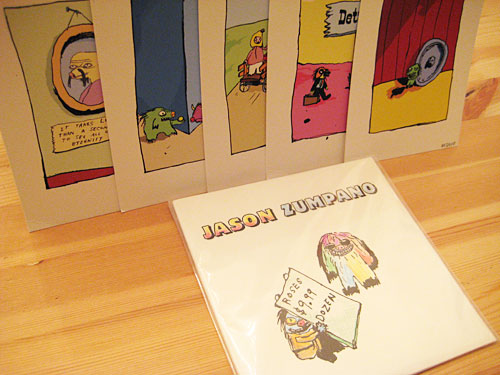
Jason Zumpano, “Roses $9.99 Dozen” + giclee/310gsm prints of art by Shayne Ehman. Catbird Records, CSP006, 2009.
JM: Given the logistics and the time spent on the Black Strawberries project, do you plan on doing another project of comparable scale? Would you use Kickstarter again for funding?
RC: I would love to do another, and yes, I would absolutely use Kickstarter again—they are such an amazing service for endeavors like this. Again, it’s the practicality issue: why drain $5000 out of your pocket to get saddled with a roomful of inventory that you may or may not sell? It seems so much more logical to get the copies spoken for first, and then have them pressed up to meet that demand.
JM: I recall a blog post of yours from right before you released Forest Fire’s Survival, where you mentioned the importance of track sequencing. And you were right: the record flows so well. Did you actually end up sequencing that album yourself? How much involvement do you have in the production of each recording?
RC: It’s definitely rare for me to get involved in “creative” aspects of a record, like the recording process or the sequencing. Survival was really just one of those rare cases where I felt a compulsion to experiment with the sequencing…and then once I did, I grew more and more convinced of my intuition about it. And man, the band was so great about it—whew! We talked and talked about it, and explored all sorts of variations on the sequence. The end result you hear is not in fact mine, but rather one that the band themselves eventually put together, after weeks of us powwowwing about it.
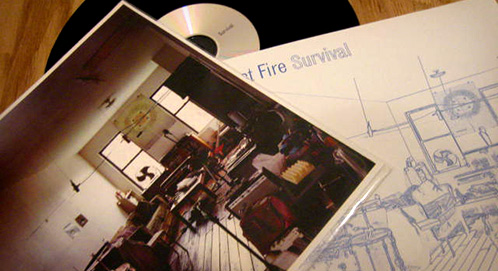
Forest Fire, “Survival” “Giant” edition. Catbird Records, CBR015, 2008. Image courtesy of Catbird Records.
JM: You’ve released records by an amazing roster of artists, from “veterans” such as Moviola, Manishevitz, and Maestro Echoplex/Fulton Lights, to relative newcomers such as Air Waves, Clear Tigers, and, most recently, Apollo Ghosts. What is your typical relationship with the artists you’ve worked with?
RC: Heh, there’s definitely no “typical” relationship, that’s for sure! With every artist, it differs greatly, but from a very simple standpoint, one thing that’s always the same is that no artist ever signs a contract or anything like that. The artist always retains all their full rights to everything, etc., and we simply agree to work together for a particular release until it’s sold out (or in some cases, just stops selling).
JM: Catbird Records is now entering its fifth year. How has your approach evolved since you sent out your first stack of hand-addressed packages, and what can we expect to see from Catbird Records in 2010?
RC: I wish I could tell you what to expect in 2010, but I’m definitely not going to go there… 2009 was my second or third year of vowing that I was going to take a break and slow down Catbird Records—and 2009 ended up being my second or third year failing to do exactly that! If the trend holds, I’m going to be here one year from today, saying the exact same thing about 2010!



